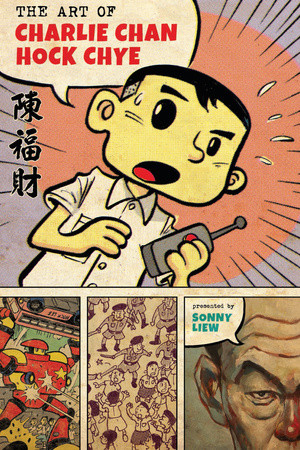The Art of Charlie Chan Hock Chye presented by Sonny Liew is an imaginative and brilliantly crafted narrative about the title man, one of Singapore’s premier comic artists.
Chan, now an old man, narrates his life story and Sonny illustrates a very personal telling. What makes this book unique and special is the integration and explanation of Chan’s comic work (though Chan is a creation of Liew’s, each has distinct flavors). Between Chan’s voice and editorial notes from Liew, Singapore’s history and politics come alive, alongside a range of comic work and day-to-day sketches. It also includes unpublished works that reflect Chan’s evolving opinions about the changes unfolding around him. To make it just a touch more meta, there are also excerpts from Chan’s unpublished autobiographical work which is very much of the style that Liew uses throughout the book. Suffice to say, it’s a little complicated to explain, but the short of it is that this is a book worth picking up.
Though I knew little of Singapore’s complicated political evolution prior to reading this, Liew and Chan’s combined explanatory powers reveal much about how people on the ground experienced these changes.
The book begins with Charlie Chan Hock Chye as an old man, then quickly goes back to Chan’s childhood and his first comic. The integrated composition, going between Liew’s narrative work and more “historical” work by Chan, is a bit jarring at first but quickly becomes familiar. Chan’s published and unpublished works waffle between fictional characters and real political figures, starting with commentary on the 1954 student protests and the Hock Lee bus riots. His Force 136 series, created in collaboration with story writer Bertrand Wong, depicted locals as cats, the Japanese as dogs, and the British as monkeys, to tell stories beyond the good guy villain trope that commented on relevant and recent events. As his publisher quips, “I thought I’d hired an illustrator…turns out I got myself a real artist!”
Woven in between the polished and published comics, we see the difficulties Chan faces trying to make a living from comics–the back and forth between publishers and artists, the economics, the instability, yet through it all his drive and commitment to his vision.
As we get further into complicated territory, Liew steps in–literally putting himself into the margins of the book to explain things. The book moves to focus on Chan’s strip Bukit Chapalang, another animal allegory dealing in particular with the possible merger of the Federation of Malaya and Singapore, Lim Chin Siong and Lee Kuan Yew.
Little Liew in the margins is delightful, adding context to veiled references. Though notes in the back explain additional information, Liew has made the perfect play on footnotes, brimming with comic relief and outrage. And it brings the hybrid possibilities of graphic novels another step forward.
The Art of Charlie Chan Hock Chye is a wonderfully satisfying trek through a man’s story and one nation’s history.
Edit: Clarifying edits that Charlie Chan Hock Chye is not a real person. I was as fooled as anyone else prior to further Googling, but I failed to share my enlightened state in the initial version of this review, which I realize could cause confusion.








